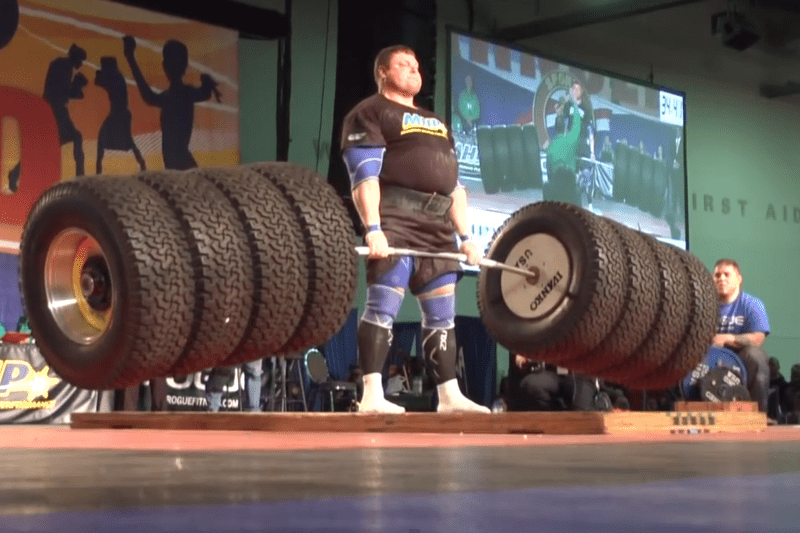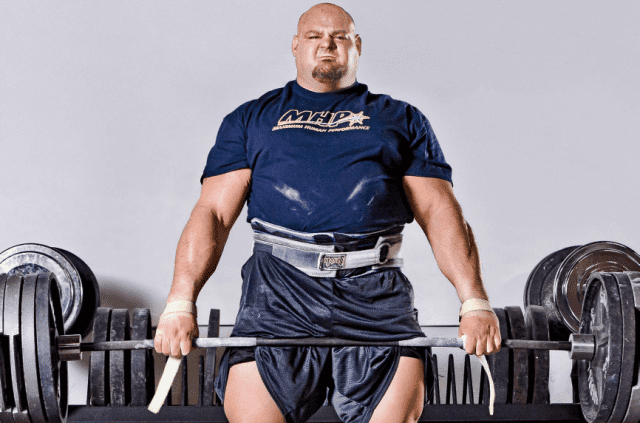
It’s hard not to marvel at the impressive weight being thrown around by professional powerlifters. But if you tune into the World’s Strongest Man competition or Olympics you may be surprised to witness the physiques of some of the highest level athletes in these competitions.
While most people expect weightlifters to look like bodybuilders this is rarely, if ever, the case. Strongmen and Olympic weightlifters are certainly large, but don’t have the muscle definition and low body fat levels of a bodybuilder.
Olympic weightlifters train for function, not aesthetics. The theory is that more mass on the body results in an improved ability to lift and move heavy weight.
So long as you are not in a competition with weight classes, the goal is to get as big and strong as possible, even if it involves holding excessive body fat.
It’s important to note the differences between weightlifters and strongman competitors. For the sake of simplicity, we’ll group Olympic lifters and powerlifters under the term weightlifters.
Believe it or not, the Olympic games only feature two lifts; the snatch and the clean and jerk. These two lifts are often called Olympic lifts for that reason.
Powerlifting typically features three lifts; the squat, deadlift, and bench press. Within these weightlifting competitions are nuances like rule sets, equipment, etc. but this is a basic overview of the two sports.
Strongman competitions are much different. Strongman competitions are a unique blend of strength and athleticism, with events like the atlas stones, farmer’s walk, and keg toss. With the endurance element of these events, you will occasionally see competitors intentionally drop body fat levels to have an edge in this department.
In fact, one of the most successful strongman competitors of all time, Mariusz Pudzianowski, was famous for his ripped physique and six pack abs. He holds the record for the most World’s Strongest Man titles with 5.
However, many strongman competitions like the Arnold Classic feature the traditional power lifts like the squat, bench, and deadlift. Larger competitors tend to excel in these events. Zydrunas Savickas, sporting a large belly, dominated the powerlifting circuit for years.
The key to success with strongman and weightlifting competitions is knowing the limitations of one’s body mass as it pertains to performance. Too small could mean not having the sheer mass to lift heavy enough weight, and too large could hamper performance as well.
Brian Shaw and Hafthor Bjornsson weigh well over 400lbs while Oleksii Novikov weighs less than 300lbs. All three have experienced success at the highest level.

There is an idea in the fitness world known as the body weight set point theory. It states that each individual has a natural weight that their body will gravitate to, even after periods of short term caloric restriction or surplus.
For example, after the holidays you may put on weight after overindulging on desserts and calorie dense foods. But what usually happens afterward is you naturally go back to your normal weight, even without purposefully trying. The body naturally finds a way to go back to the mean as it pertains to body weight.
Of course, overindulging for a long enough period will lead to permanent weight gain. The illustration was explained to show that the body will revert to your natural weight within reasonable conditions.
Strongmen and powerlifters are obviously trying to put on weight, and have likely broken through that body weight set point. However there is still a point where diminishing returns set in, where additional weight is actually detrimental to performance. You can’t just be a ball of mass and expect to toss kegs over a 20 foot wall.
The trend has shifted slightly in strongman (not as much in powerlifting or Olympic lifting), where some of the athletes have experimented with competing at lower body weights. As mentioned, there are more elements of athleticism and endurance to strongman than standard Olympic lifting. It is up to the individual athlete to determine what body weight is optimal to balance both the strength and endurance aspects of the sport.

Are Strongmen Healthy?
There has been a recent, troubling trend in bodybuilding where many top competitors have died suddenly with no previous signs of poor health. While weightlifters and bodybuilders compete in two completely different sports, they still share some similar qualities.
Experts have tried to determine what has lead to the death of these bodybuilders, who are often in the prime of their careers in their 20’s and 30’s. The obvious impromptu response will point to the use of steroids and other performance enhancing drugs.
Steroids are a given in professional bodybuilding, but are aldo an overlooked aspect of strongman and powerlifting. The Olympics obviously test for performance enhancing drugs, but there are holes in the testing process which can make it easy to get around if you know how to time things. The Olympics are no strangers to PED controversy, even in recent history.
While steroid use isn’t as rampant in powerlifting as it is in bodybuilding, it would be naïve to think that many elite competitors aren’t using them.
Another aspect related to health defects that is often neglected is the massive body mass that these competitors carry year round. Bodybuilders can weigh upwards of 300lbs in the offseason and as mentioned, some powerlifters and strongmen are over 400lbs during competition.
Carrying that weight puts a huge amount of stress on the body and is unnatural to some degree. Basic internal functions become more difficult when body weight is high.
This is even the case for athletes. Despite a great proportion of that weight coming in the form of muscle, it can still have a negative effect.
With that being said, a 300lb powerlifter is objectively healthier than a 300lb sedentary, obese individual. Having increased levels of muscle is beneficial for a variety of reasons. Also elevating heart rate from intense workouts is good for cardiovascular health. But it still should be noted that the extra mass can still be detrimental to health, even if that person is physically active.
The good news is that the powerlifting and strongman communities have avoided the tragic, sudden deaths that have plagued bodybuilding. The sport is generally viewed in a positive light and does not have the black cloud looming that others do.
Recent Posts
There is no greater appeal in the fitness world than the prospect of eating junk food and still effectively building muscle. With how calorie dense fast food is, coupled with the lack of...
Strength and conditioning is a major part of any modern athlete’s overall training routine for sport. A greater emphasis has been placed on strength and conditioning in recent time, particularly as...
